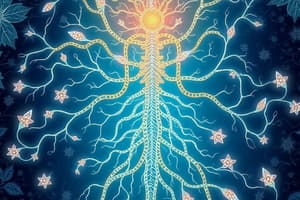Podcast
Questions and Answers
Which part of the nervous system consists of the brain and spinal cord?
Which part of the nervous system consists of the brain and spinal cord?
- Autonomic Nervous System
- Central Nervous System (correct)
- Somatic Nervous System
- Peripheral Nervous System
Which of the following is NOT a division of the Autonomic Nervous System?
Which of the following is NOT a division of the Autonomic Nervous System?
- Enteric Nervous System
- Sympathetic Nervous System
- Somatic Nervous System (correct)
- Parasympathetic Nervous System
What are the two major divisions of the somatic nervous system?
What are the two major divisions of the somatic nervous system?
Cranial nerves and spinal nerves
The enteric nervous system is often referred to as the 'second brain.'
The enteric nervous system is often referred to as the 'second brain.'
The protective membranes surrounding the brain are known as the ______.
The protective membranes surrounding the brain are known as the ______.
What does the sympathetic nervous system primarily prepare the body for?
What does the sympathetic nervous system primarily prepare the body for?
Which plane divides the brain into right and left halves?
Which plane divides the brain into right and left halves?
Match the following types of brain tissue with their descriptions:
Match the following types of brain tissue with their descriptions:
What are gyri and sulci in the context of the cerebral cortex?
What are gyri and sulci in the context of the cerebral cortex?
Flashcards are hidden until you start studying
Study Notes
Nervous System Divisions
- The nervous system is divided into the central nervous system (CNS) and the peripheral nervous system (PNS).
- The CNS encompasses the brain and spinal cord.
- The PNS consists of all nervous system components outside the skull and spinal column.
- Nerves are bundles of axons found outside the CNS.
Peripheral Nervous System
- The PNS is further divided into the somatic, autonomic, and enteric nervous systems.
- The somatic nervous system connects the brain to major muscles and sensory systems.
- The autonomic nervous system controls the viscera (internal organs).
- The enteric nervous system is a local network of neurons that governs the gut's function.
Somatic Nervous System
- The somatic nervous system has two divisions: cranial nerves and spinal nerves.
- Cranial nerves are 12 pairs of nerves emerging directly from the brain.
- Spinal nerves are 31 pairs of nerves emerging from the spinal cord, connecting it to the body.
Autonomic Nervous System
- The autonomic nervous system comprises three divisions: sympathetic, parasympathetic, and enteric.
- The sympathetic nervous system prepares the body for action (fight or flight), increasing heart rate, blood pressure, and pupil dilation.
- The parasympathetic nervous system counteracts sympathetic activity, promoting rest and digestion.
- The enteric nervous system, also called the "second brain," governs gastrointestinal function, operating largely independently from the CNS but communicating with it.
Brain Views
- Six brain views are commonly used for anatomical study: anterior, posterior, dorsal, ventral, lateral, and midsagittal.
Brain Orientation
- Three planes are used to divide the brain and body: horizontal, sagittal, and coronal.
- The horizontal plane divides the brain into dorsal (upper) and ventral (lower) parts.
- The sagittal plane divides the brain into right and left halves; midsagittal refers to the central division.
- The coronal plane divides the brain into anterior (front) and posterior (back) regions.
Brain Tissue
- Brain tissue consists of two main types: white matter and gray matter.
- White matter is composed primarily of axons with white myelin sheaths.
- Gray matter contains more cell bodies and dendrites, lacking myelin.
- Axon bundles are called fiber/tracts, while collections of neurons are called nuclei.
Cerebral Cortex
- The cerebral cortex is the outermost layer of the brain involved in higher-level processing.
Longitudinal Fissure
- The longitudinal fissure separates the left and right cerebral hemispheres.
Frontal Lobe
- The frontal lobe is responsible for higher-level cognition and motor control.
Studying That Suits You
Use AI to generate personalized quizzes and flashcards to suit your learning preferences.




